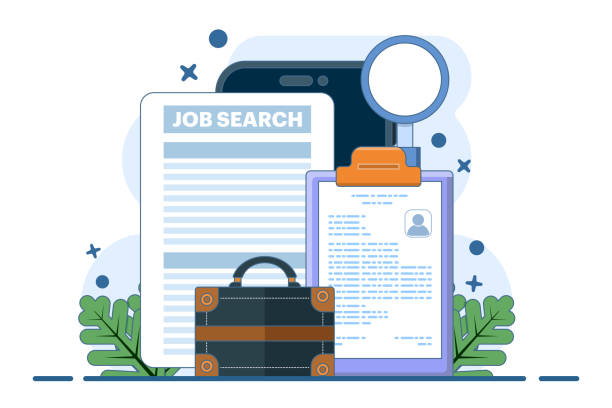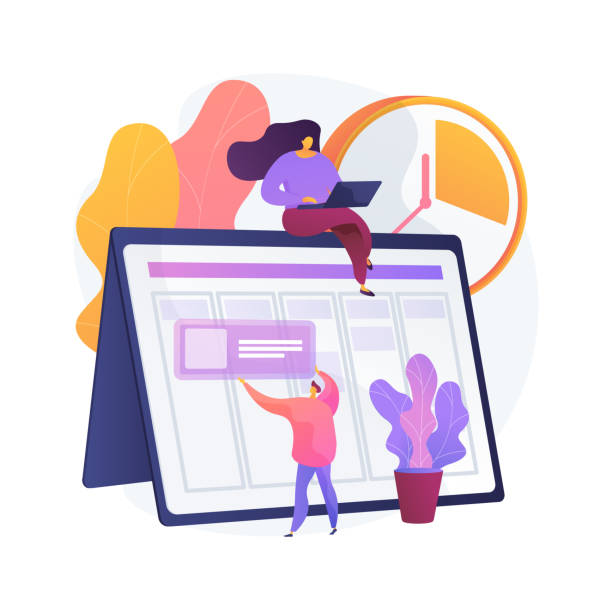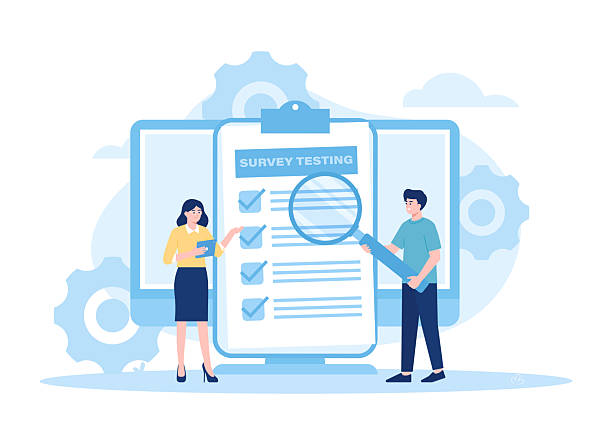Introduction to User-Friendly Website Design and Its Importance in the Digital Age

In today’s world, where the internet has become an inseparable part of our daily lives, having a website is not merely about having an online presence, but rather the quality of this presence and the level of user interaction with it are of vital importance. #UserFriendlyWebsiteDesign is no longer a luxury choice, but a necessity for every business and individual aiming for sustainable success in the web space.
This approach is based on the idea that users should have an easy, enjoyable, and seamless experience when visiting a website.
This section provides a comprehensive explanation of why this concept is important.
A poorly designed website can lead to high bounce rates, reduced brand credibility, and lost business opportunities, even if it has very valuable content.
In contrast, user-friendly websites can convert visitors into loyal customers and significantly increase conversion rates.
This is not just about aesthetic appeal, but also includes a smooth and logical User Experience (UX) and User Interface (UI).
The main goal is for users to be able to quickly and easily access the information they need, without encountering unnecessary complexities or confusing designs.
Ultimately, user-friendly website design ensures that your website is not only seen but also remembered by users for the good experience it provides. This approach is particularly crucial for online businesses, as every user interaction with the site directly influences their final decision to purchase or use services.
A deep understanding of user needs and behaviors is the cornerstone of this type of design.
Are you bothered by losing customers due to your e-commerce site’s outdated look or slow speed? Rasaweb’s expert team solves these problems with professional e-commerce website design!
✅ Increase customer trust and your brand’s credibility
✅ Blazing speed and excellent user experience
Get a free consultation with Rasaweb right now ⚡
Fundamental Principles of User Experience (UX) in Web Design

To achieve user-friendly website design, understanding and applying the fundamental principles of User Experience (UX) is crucial.
This specialized section examines these principles and how they can transform a dry informational page into an interactive and enjoyable platform.
One of the most important of these principles is Usability; meaning users can easily perform their tasks on the site with minimal effort.
This includes intuitive navigation, simple forms, and clear error messages.
Another principle is Accessibility, which ensures the website is usable for all users, including those with disabilities.
This requires adhering to specific standards such as appropriate color contrast and compatibility with screen readers.
Efficiency is also highly important; users should be able to achieve their goals quickly, without spending a lot of time loading pages or finding information.
Consistent design throughout the site, including the use of similar fonts, colors, and layouts, helps users quickly become familiar with the environment and avoid feeling lost.
Finally, Desirability refers to the emotional and aesthetic aspects of the site that make users enjoy interacting with it, not only logically but also emotionally.
Adhering to these principles at every stage of the user-friendly website design process will guarantee a positive and lasting experience for visitors.
The Importance of Responsive Design and Mobile-First Approach

In today’s world, where most users access the internet via their mobile phones, the importance of responsive design and the “mobile-first” approach in user-friendly website design has become more apparent than ever.
This analytical section explains the why and how of this approach and provides guidelines for its implementation.
Responsive design means that your website automatically adapts its size and layout to the screen size of the user’s device (mobile, tablet, laptop, or desktop). This ensures a seamless user experience across all devices and eliminates the need to design separate versions for each platform.
Given that Google also prioritizes mobile-optimized websites in its rankings, this is beneficial not only for users but also for your website’s SEO.
The “Mobile-First” approach means that the website design and development process begins by considering the user experience on mobile devices first, and then gradually expands to larger screens.
This method ensures that the most important content and functionalities are optimally accessible to mobile users.
Ignoring this aspect can lead to losing a significant portion of your audience and reducing your website’s performance.
A user-friendly website design without considering this principle will be incomplete and ineffective.
Below, a comparative table between mobile-first and desktop-first design is provided.
| Feature | Mobile-First Design | Desktop-First Design |
|---|---|---|
| Design Starting Point | Smallest Screen (Mobile) | Largest Screen (Desktop) |
| Content and Features | Essential elements first, then add extras | All elements, then remove or modify for mobile |
| Performance Optimization | Strong focus on speed and low volume | May pay less attention to speed and volume |
| User Experience | Integrated and fluid across all devices | May encounter problems on smaller devices |
Designing Intuitive Navigation and Efficient Information Architecture

One of the most important pillars of user-friendly website design is its navigation system and Information Architecture (IA).
This section guides you on how to lead visitors to their desired destination without confusion and ensure that everything they need is easily accessible.
Information Architecture refers to the organization and labeling of content on a website, so that users can quickly find and understand information.
This includes designing the structure of menus, categories, and page hierarchies.
A weak IA can frustrate users and drive them to leave the site.
To create intuitive navigation, you must use clear and understandable language and labels.
Navigation menus should be visible and located where users expect them (e.g., at the top of the page or in the sidebar).
Using breadcrumbs (navigation path) also helps users understand their location within the site.
Furthermore, an efficient search functionality is essential for sites with a lot of content, allowing users to be directed directly to the information they are looking for.
A logical and clear navigation structure not only improves user experience but also helps search engines better understand and index your site’s content. This directly has a positive impact on your website’s SEO and causes users to spend more time on your site.
Ultimately, always put yourself in the user’s shoes and try to optimize the path they take to reach their goal.
This educational section helps you become familiar with the principles and techniques of this vital part.
Are you tired of your company’s website not meeting your expectations? With Rasaweb, design a professional website that truly represents your business.
✅ Increase new customer acquisition and sales leads
✅ Boost your brand’s credibility and trust among your audience
⚡ Get a free website design consultation!
The Importance of Attractive Visual Design and Accessibility for All Users

Visual aesthetics in user-friendly website design are more than just a pretty appearance; they are a powerful tool for attracting and retaining user attention.
This explanatory and specialized section discusses how visual elements, alongside accessibility principles, can significantly enhance the user experience.
An attractive visual design involves the clever use of colors, typography, white space, and imagery that not only makes the site aesthetically pleasing but also aids in information clarity.
Colors can evoke specific emotions and affect text readability; therefore, choosing an appropriate color palette consistent with brand identity and site purpose is essential.
Proper typography includes selecting readable fonts, appropriate text size, and correct line spacing to ensure users can read content easily without fatigue.
The use of white space (negative space) also helps in separating elements and reducing visual clutter, making content easier to digest.
However, beauty is not complete without accessibility.
Accessibility means ensuring that your website is usable by everyone, including those with visual, auditory, motor, or cognitive disabilities.
This includes providing alternative text (alt text) for images, using high color contrast, supporting keyboard navigation, and providing captions for videos.
Adhering to these principles is not only an ethical imperative but can also expand your target market and help comply with legal standards.
WCAG (Web Content Accessibility Guidelines) standards published by the W3C serve as a comprehensive guide for creating accessible websites.
Ultimately, user-friendly website design means creating an environment where all users can easily and enjoyably interact with it, regardless of their abilities or limitations.
Content Strategy for Enhanced User Engagement

Content is king; this is an established truth in the web world, but in user-friendly website design, the type and quality of content are of particular importance.
This entertaining and analytical section explores how to develop a content strategy that not only conveys information but also encourages users to interact, share, and return to the site.
Your content must be relevant, valuable, and tailored to the needs and interests of your target audience. This means that first and foremost, you need to know your audience well and understand what kind of information they seek and what format they prefer.
Are they interested in long, in-depth articles, or do they prefer infographics and short videos? Using the right tone, storytelling, and engaging visual content (as high-quality images and videos) can significantly enhance content appeal.
Furthermore, interactive content such as polls, quizzes, and comment sections encourages users to actively participate on the site.
Regular content updates not only encourages users for future visits but also signals to search engines that your site is active and dynamic, which is an important SEO factor.
Your content should answer user questions and solve their problems, rather than just promoting your products or services.
A user-friendly website design with rich and engaging content can transform ordinary visitors into your brand ambassadors and naturally increase organic site traffic.
The quality and originality of content, coupled with simplicity of understanding, are key to success in this area.
Optimizing Website Performance and Loading Speed

Website loading speed is one of the most important factors in user-friendly website design, directly impacting user experience and search engine rankings.
This news and specialized section examines solutions and the importance of performance optimization.
Research has shown that even a one-second delay in page loading can increase bounce rates by up to 7% and severely reduce customer satisfaction.
Today’s users are impatient and expect web pages to load instantly.
Therefore, optimizing loading speed has become a critical priority for every website.
There are several strategies to increase website speed:
- Image Optimization: Compressing images without reducing quality, using next-gen formats (like WebP), and lazy loading images.
- Caching: Utilizing caching mechanisms to temporarily store files in the user’s browser for faster loading on subsequent visits.
- File Compression (Gzip): Compressing CSS, JavaScript, and HTML files before sending them to the user’s browser.
- Reduce HTTP Requests: Combining CSS and JavaScript files and minimizing the number of requests to the server.
- Using a Content Delivery Network (CDN): Placing site content on servers closer to users to reduce latency.
- Code Optimization: Cleaning unnecessary CSS and JavaScript code and using Minification.
Google, in its algorithm updates, also considers page speed as an important ranking factor and provides tools like PageSpeed Insights to help webmasters.
Therefore, user-friendly website design would not be complete without considering speed.
A fast website not only keeps users satisfied but also significantly contributes to SEO and increased conversion rates.
Below, a table of important tools for checking and improving website speed is provided.
| Tool | Description | Primary Use |
|---|---|---|
| Google PageSpeed Insights | Provides speed scores for mobile and desktop along with improvement suggestions | Performance analysis and solution provision |
| GTmetrix | Comprehensive speed analysis using YSlow and PageSpeed, waterfall report | Comprehensive performance and loading resource review |
| WebPageTest | Ability to test speed from various locations worldwide and different browsers | Precise testing and simulation of real user conditions |
| Lighthouse (Chrome DevTools) | Built-in Chrome browser auditing tool for performance, accessibility, and SEO | Quick and internal site audit |
The Importance of User Testing and Feedback for Continuous Improvement
![]()
After implementing the principles of user-friendly website design, your work is not over.
In fact, the process of improving a user-friendly website is a continuous cycle that requires testing, gathering user feedback, and iteration.
This question-provoking and guiding section shows you how to continuously improve your website using these techniques.
Do you know how users actually interact with your site? Are your assumptions about user behavior correct? Usability Testing allows you to observe real user behavior and identify the strengths and weaknesses of your design.
These tests can include qualitative tests (such as interviewing users and observing them performing tasks) or quantitative tests (such as A/B Testing).
Collecting direct feedback from users through surveys, feedback forms, or user behavior monitoring tools (such as heatmaps and session recordings) is also invaluable. This feedback can provide deep insights into user pain points, unmet expectations, and even new features that might be useful.
This continuous feedback process allows you to optimize your design based on real data, not just guesswork.
A user-friendly website design is always evolving and never reaches a final point, as user needs and expectations are constantly changing.
Ignoring this step can mean stagnation and falling behind competitors.
By using user data and feedback, you can make evidence-based decisions that lead to continuous improvement in user experience and, consequently, greater online success for your website.
This not only increases user satisfaction but also directly impacts your conversion rates and profitability.
Does your company’s website create a professional and lasting first impression in the minds of potential customers? Rasaweb, with its professional corporate website design, not only represents your brand’s credibility but also opens a path for your business growth.
✅ Create a powerful and trustworthy brand image
✅ Attract target customers and increase sales
⚡ Get a free consultation
The Impact of User-Friendly Design on SEO and Search Engine Rankings

The connection between user-friendly website design and SEO may not be immediately obvious, but these two concepts are strongly intertwined.
This analytical section explains how a user-friendly design positively impacts your website’s ranking in search engines.
Google and other search engines are increasingly emphasizing user experience as a ranking factor.
Their algorithms look for websites that provide the best experience for their users.
Factors such as page loading speed, mobile responsiveness, dwell time, bounce rate, and pages per session are all important metrics directly affected by user-friendly design.
A fast and responsive website with easy navigation keeps users on the site longer, reduces bounce rates, and increases the likelihood of clicking on other pages.
These signals indicate to search engines that your website has valuable content and offers a positive experience, thereby improving your ranking.
Furthermore, a logical structure and efficient information architecture implemented in a user-friendly website design help search engine crawlers better index and understand your site’s content.
Title tags, meta descriptions, and internal links, which are part of user-friendly design, also contribute to SEO.
In fact, if you want your website to be visible in search results, you must first address the needs and expectations of your users.
Investing in user-friendly website design is an investment in your website’s long-term SEO and sustainability.
This synergy between UX and SEO ensures success in today’s competitive landscape.
Future Trends and the Importance of Continuous Learning in Web Design

The world of user-friendly website design is constantly changing and evolving.
New trends, emerging technologies, and shifts in user expectations require designers and developers to continuously learn and update their knowledge. This news and entertaining section explores some of these future trends and the importance of preparing for them.
Artificial Intelligence (AI) and Machine Learning (ML) will play an increasing role in personalizing user experience, from smart chatbots to customized content recommendations.
Voice design and screenless interactions, such as Voice User Interfaces (VUIs) for smart assistants, are also expanding and demand new design approaches.
Augmented Reality (AR) and Virtual Reality (VR) have the potential to create entirely new interactive experiences that can revolutionize how we interact with websites.
Additionally, the focus on sustainability and green design in web is growing, meaning designers will seek ways to reduce energy consumption and the environmental impact of websites.
To succeed in this dynamic environment and consistently deliver user-friendly website design, it is essential to actively pursue learning.
Participating in webinars, reading specialized articles, joining professional associations, and experimenting with new technologies are all ways to stay current.
This educational section emphasizes the importance that your knowledge in this field should never remain static.
The future of user-friendly website design is exciting and full of innovation, and only those who adapt to changes and continuously embark on the path of learning can lead in it.
This forward-thinking approach helps you constantly build websites that not only meet today’s user needs but are also prepared for tomorrow’s challenges and opportunities.
Frequently Asked Questions
And other services by Rasaweb Advertising Agency in the field of advertising
Smart Website Development: A combination of creativity and technology for campaign management through SEO-driven content strategy.
Smart UI/UX: A new service to increase click-through rates by optimizing key pages.
Smart Data Analysis: Transform online growth with smart data analysis.
Smart Advertising Campaign: A fast and efficient solution for online growth focusing on smart data analysis.
Smart Website Development: A creative platform to improve user engagement with marketing automation.
And over hundreds of other services in internet advertising, advertising consultation, and organizational solutions
Internet Advertising | Advertising Strategy | Advertorial
Resources
What is User-Friendly Website Design?The Importance of User Experience in SEOUser Experience Design TrainingWebsite Speed Optimization for Better UX
? To reach the pinnacles of success in the online world, Rasaweb Digital Marketing Agency is your smart business companion. With our expertise, SEO-optimized website design is no longer a dream, but a high-yield reality.
📍 Tehran, Mirdamad Street, next to Bank Markazi, Southern Kazeroon Alley, Ramin Alley, No. 6



